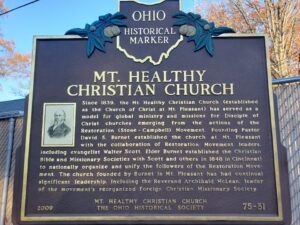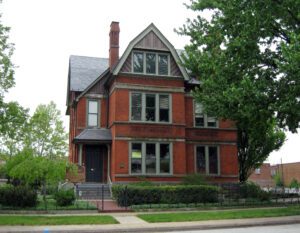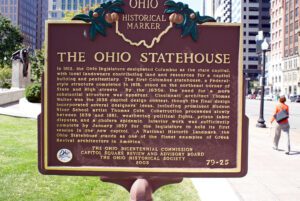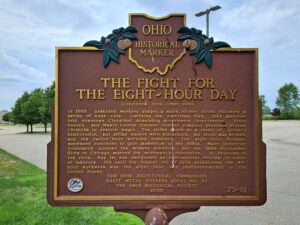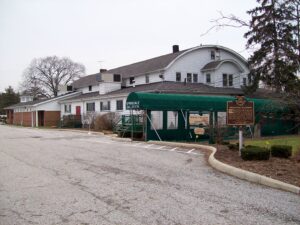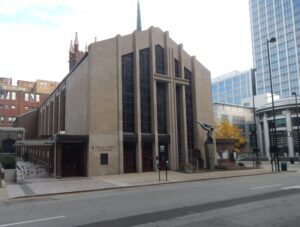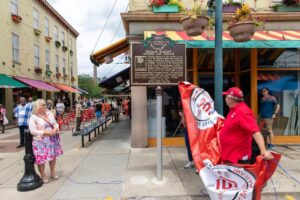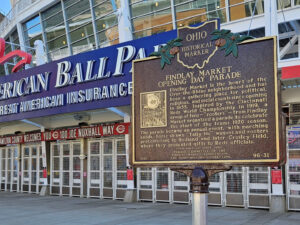, OH
Since 1839, the Mt. Healthy Christian Church (established as the Church of Christ at Mt. Pleasant) has served as a model for global ministry and missions for Disciple of Christ churches emerging from the actions of the Restoration (Stone-Campbell) Movement. Founding Pastor David S. Burnet established the church at Mt. Pleasant with the collaboration of Restoration Movement leaders, including evangelist Walter Scott. Elder Burnet established the Christian Bible and Missionary Societies with Scott and others in 1848 in Cincinnati to nationally organize and unify the followers of the Restoration Movement. The church founded by Burnet in Mt. Pleasant has had continual significant leadership, including the Reverend Archibald McLean, leader of the movement’s reorganized Foreign Christian Missionary Society.
, OH
The Sarah Benedict House is a rare survivor of the once fashionable Upper Prospect neighborhood that included “Millionaires Row” on adjacent Euclid Avenue. Sarah Rathbone Benedict had this Queen Anne-inspired house built in 1883, when she was 68, and lived here until her death in 1902. She was active in the social, religious, and charitable life of Cleveland. Sarah Benedict was the widow of George A. Benedict, editor of the Cleveland Daily Herald. The house was given to the Cleveland Restoration Society by Dr. Maxine Goodman Levin in 1997 and rehabilitated for its headquarters in 1998. It is listed in the National Register of Historic Places and contributes to the locally designated Prospect Avenue Historic District.
, OH
In 1812, the Ohio legislature designated Columbus as the state capital, with local landowners contributing land and resources for a capitol building and penitentiary. The first Columbus statehouse, a Federal-style structure completed in 1816, stood on the northeast corner of State and High streets. By the 1830s, the need for a more substantial structure was apparent. Cincinnati architect Thomas Walter won the 1838 capitol design contest, though the final design incorporated several designers’ ideas, including prominent Hudson River School artist Thomas Cole. Construction proceeded slowly between 1839 and 1861, weathering political fights, prison labor disputes, and a cholera epidemic. Interior work was sufficiently complete by January 1857 for the legislature to hold its first session in the new capitol. A National Historic Landmark, the Ohio Statehouse stands as one of the finest examples of Greek Revival architecture in America.
, OH
Organized efforts to establish an eight-hour workday existed as early as 1866 in the United States. The Cleveland Rolling Mills Strikes of 1882 and 1885, as part of this almost-70-year struggle, contributed to the establishment of the eight-hour workday. Both strikes challenged the two-shift, twelve-hour workday in addition to seeking recognition of the Amalgamated Association of Iron, Steel, and Tin Workers. The first strike – by English, Welsh, and Irish skilled workers – was at the Newburgh Rolling Mills, a major producer of steel rails for the rapidly expanding railroad industry that once stood near this site. It was quickly broken when unskilled Polish and Czech immigrants, unaware of the ongoing labor dispute, were hired. The strike ended when these new workers did not support the union. (continued on other side)
, OH
Springvale Ballroom is located on part of the one hundred and forty acre tract that English immigrant John Biddulph bought in 1840. Fred Biddulph, John Biddulph’s grandson, was born near this site in 1887. Fred and his wife, Clara, built the five thousand square foot Springvale Ballroom. On May 19, 1923, they paid fifteen dollars for the right to open the dancing pavilion. The first dance at Springvale Ballroom was held on May 23rd. A five hole golf course was added to the property in 1928. Later changes to Springvale included renovation of the ballroom, the addition of a golf office, and an upgrade to a full eighteen hole course.
, OH
In 1817 twenty-two men, including future President William Henry Harrison, chartered Cincinnati’s first Episcopal parish, Christ Church. In 1835 members erected a Gothic Revival-style church on this site. The neighborhood evolved as the city grew with the influx of immigrants. Parish women raised funds to teach, feed, clothe, and shelter tenement families, and alleviate suffering during floods and disease outbreaks. In 1883 the women helped establish what became Cincinnati Children’s Hospital. In 1909 members opened the Late Gothic-style Parish House, a community center with kitchen, classrooms, library, auditorium, clinic, gymnasium, and bowling alley. By the parish’s centennial in 1917, music had expanded beyond worship to public concerts. In 1940 the annual Boar’s Head Festival of music and pageantry began. Since the 1960s, members have collaborated with local agencies to advocate for social and economic justice, a mission continuing into the 21st century. (Continued on other side)
, OH
Findlay Market is the heart of the Over-the-Rhine neighborhood and has been a gathering place for political, religious, and social events since opening in 1855. Inspired by the Cincinnati Reds World Championship in 1919, a group of fans –“rooters” – from Findlay Market organized a parade to celebrate the start of the team’s 1920 season. The parade became an annual event, with marching bands, horse-drawn “Tally-Ho” wagons and rooters processioning to Redland and later Crosley Field, where they presented gifts to Reds officials. (Continued on other side)
, OH
Findlay Market is the heart of the Over-the-Rhine neighborhood and has been a gathering place for political, religious, and social events since opening in 1855. Inspired by the Cincinnati Reds World Championship in 1919, a group of fans – “Rooters” – from Findlay Market organized a parade to celebrate the state of the team’s 1920 season. The parade became an annual event, with marching bands, horse-drawn “Tally-Ho” wagons and rooters processioning to Redland and later Crosley Field, where they presented gifts to Reds officials. (Continued on other side)


